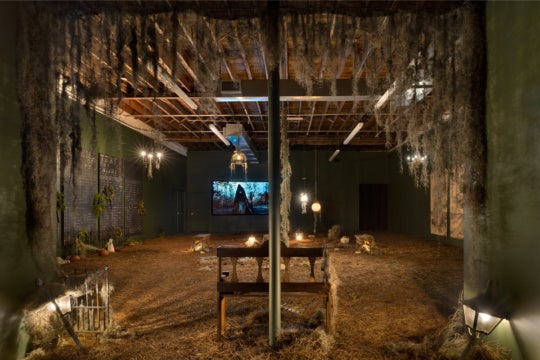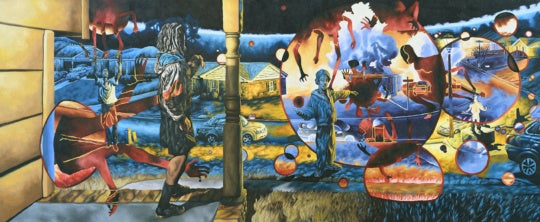
Early Modernism saw two visions of the relationship between art and life emerge. One held that art was autonomous, whereas the other sought to integrate art and life. The former, traceable to such artists as Velazquez and Manet, and subsequently brought to the fore by the Abstract Expressionists and Clement Greenberg, is supposedly self-referential and self-reliant. The latter can be shown to move in two directions; one, via Russian Constructivism as influenced by Marxist historical materialism and the Bolshevik Revolution, sought to dissolve art into life; the other, sometimes associated with rationalist utopianisms of the Bauhaus, De Stijl, and other movements in western Europe, sought to make all of life an aesthetic experience. Two lines, faint and meandering as they may be, can be drawn from the two aforementioned primary modes to the two major ways of making art today. Autonomous, self-referential art could be associated more with objects of the gallery or museum (and permanent outdoor sculpture), while work descendant of “art-merging-with-life” relates more to performance and outside-the-gallery happenings. Throughout the Modern period, myriad art movements have leaned one way or the other in attempts at creating an art that would most accurately reflect and critique the Modern experience. Often, this critique was focused on the project of capitalism; paradoxically, artists of both camps remain reliant on capitalists in order to subsist.

Some critical thinkers move beyond the paradoxical relationship with capitalism into the precipitous problem of experience. Walter Benjamin, in an essay titled “Experience” (1913), concludes that an adult (probably an analogy for modernity) loses the ability to have real life experiences in favor of knowledge and cynicism. Giorgio Agamben furthers Benjamin’s thesis in Infancy and History (1978), wherein he applies a linguistic-semiological interpretation to the problem, suggesting that the only thing we experience is language, and our most valued experiences relate to words with no clear referent. For neither writer is experience merely raw stimulus reception, but that which changes us on a deeper level. As Agamben notes, “For modern man’s average day contains virtually nothing that can still be translated into experience. Neither reading the newspaper, with its abundance of news that is irretrievably remote from his life, nor sitting for minutes on end at the wheel of his car in a traffic jam…Modern man makes his way home in the evening, wearied by a jumble of events, but however entertaining or tedious, unusual or commonplace, harrowing or pleasurable they are, none of them will have become experience.”

I would think that for many people, this analysis rings particularly true in today’s smart-phone-web-2.0-html5-world. Everywhere you look, people are face down, attentive to a glowing screen, “doing” something other than experiencing the physical world immediately around them. Even when a spectacle worthy of drawing one’s attention away from the screen presents itself, many are still obliged to mediate that experience through the screen via obsessive picture taking or video making. As one can tell by the date of Benjamin’s essay, although our technologies are new, the phenomena that follow are not.
Similar ideas can be found in the writings on Situationism from the 1950s and 1960s, and on Relational Aesthetics from the turn of the 21st century. The argument for a more real and imminent relationship to the world is often used to build a case against museums, galleries, and static art in general, in favor of public and interactive art. I believe that the argument has become so common that it is often accepted on its face value, and its flaws never emerge. I also believe that an examination of the questions I present below can help Atlanta’s art scene, inside and outside the gallery, to strengthen and continue to grow.

The first problem is that certain experiences are given preference; the “real” kind are seen as deep and valuable, and the “virtual” kind as passive and meaningless. This bias boils down to a kind of Kantian relativism, in which subjective taste is mistaken for universal law. Although I think most people do find real life more meaningful than a virtual one, the distinction becomes blurred when choosing between mediated experiences. Why do so many of us find information from a book, even if it’s fiction, more important than televised drama? Why can some people sit before a computer all day, then brag about how they “don’t even own a TV”? A mediated experience is a mediated experience—just because a person is dressed up, dancing on the corner of the street, does not make the event more real than someone doing the same thing on a proscenium stage. Personal and social boundaries define the line between “real” space and make-believe, thus the definition of mediated is dependent on each viewer’s psychology.

The second problem is more directly related to the idea of experience, specifically with regard to the popular argument that public interactive works create a sense of physical community, as opposed to virtual, online interaction. In today’s hyper-mediated world, a carnival-style art event is equally likely, if not more likely, to be experienced through the lens of a camera phone than is a gallery show. Also, for many, to “experience” such events as Flux Projects’ one-night art extravaganza, Elevate: Art Above Underground, or similar happenings is to follow a map and a schedule analogous to some bourgie version of TV Guide.

Finally, the pace required to “see” all of the art at any of these events often mimics the pace required to get a plasma television on Black Friday, leaving little time to socialize with the company in one’s midst. By comparison, the conversation-filled, wine-sipping, partylike atmosphere of any gallery opening may have more to offer in terms of creating community than the best open-air festival. At the same time, the ratio of numbers of works to amount of time a given festival occurs can be unkind to a viewer trying to interact with all the work to be seen. While this evanescence is representative of the drive-by nature of contemporary real-life interaction, it is also counter to being able to engage with the work on a deeper level. By contrast, in the days or weeks following the opening of a gallery show (the opening being a time when work probably gets the least amount of attention), one can stand in front of a work at one’s own pace, take time to communicate, and make a real, deep connection with the work, in a way described by James Elkins in his series of essays How Long Does It Take to Look at a Painting.
Obviously, I am not calling for an end to public art events. They are great fun and offer opportunities for artists to make, and viewers to experience, works that are disproportionate to the gallery. I have participated in them, and will continue to do so, both as an artist and a viewer. I do wonder though: Why is there such a push to move art outside the gallery? If all of our experience is mediated by technology, what difference does it make where art exists? What does art outside the gallery promote that art inside a gallery does not? Does the apparent need to evangelize the visual arts mark a failure in its ability to compete with the kitsch found on television, in movie theatres, and the on the Internet; are we, as “fine” artists jealous of the popularity of these “lower” art forms? Most importantly, I question why we go to such lengths to produce and receive art: to be able to say that we have experienced its existence, or to actually improve our own existence and experience?
Who’s Afraid of Four White Walls? Or Have You Ever Been Experienced?
Related Stories
Call For Artists
Reviews
Studio Visit
Call for Artists: July 2025
Our monthly round of opportunities includes a resident artist program for craft artists in Penland, a residency in Knoxville, and an open call for installation-based solo exhibitions in Miami,
Diedrick Brackens: the shape of survival in the Walter and Linda Evans Center for African American Studies at the SCAD Museum of Art, Savannah
Anna Nelson-Daniels reviews Diedrick Brackens: the shape of survival in the Walter and Linda Evans Center for African American Studies at the SCAD Museum of Art, Savannah.
In the Studio with Tim Short
Tyra Douyon visits the studio of Tim Short, a narrative painter based in Stone Mountain, Georgia, to speak on the imaginative and metaphysical iconography tied to Blackness.




